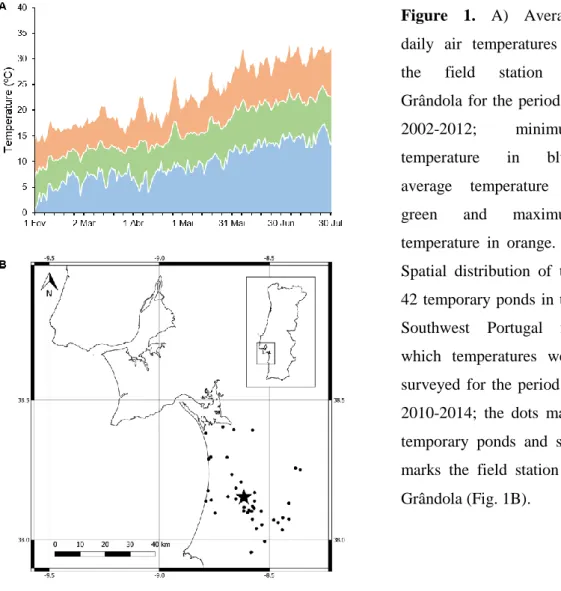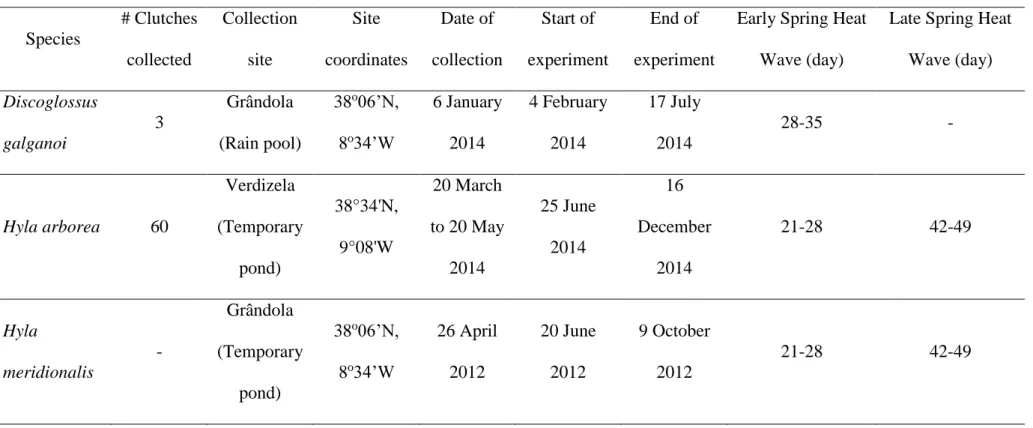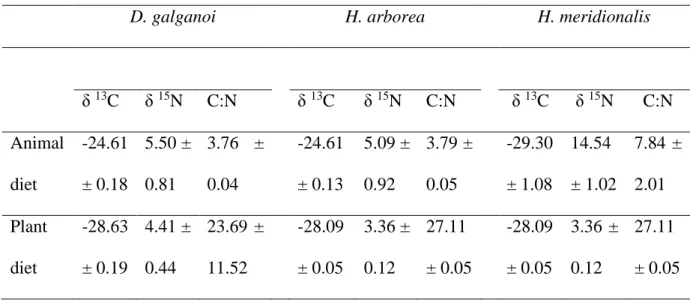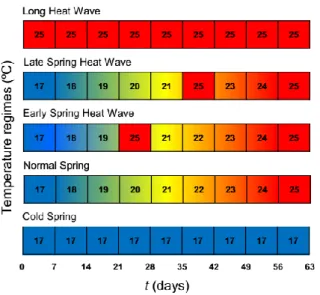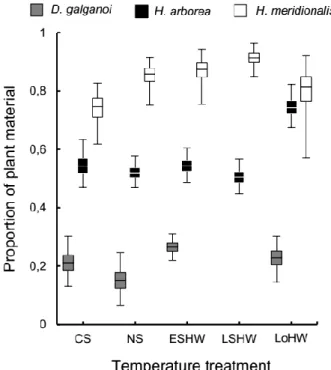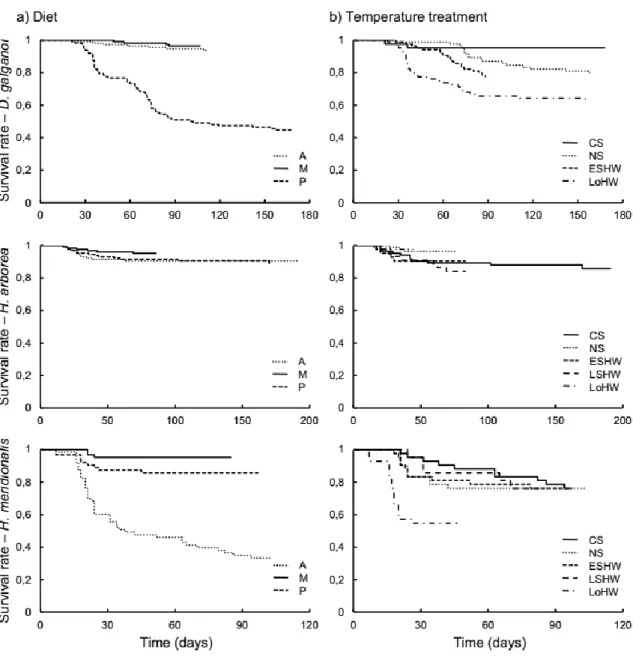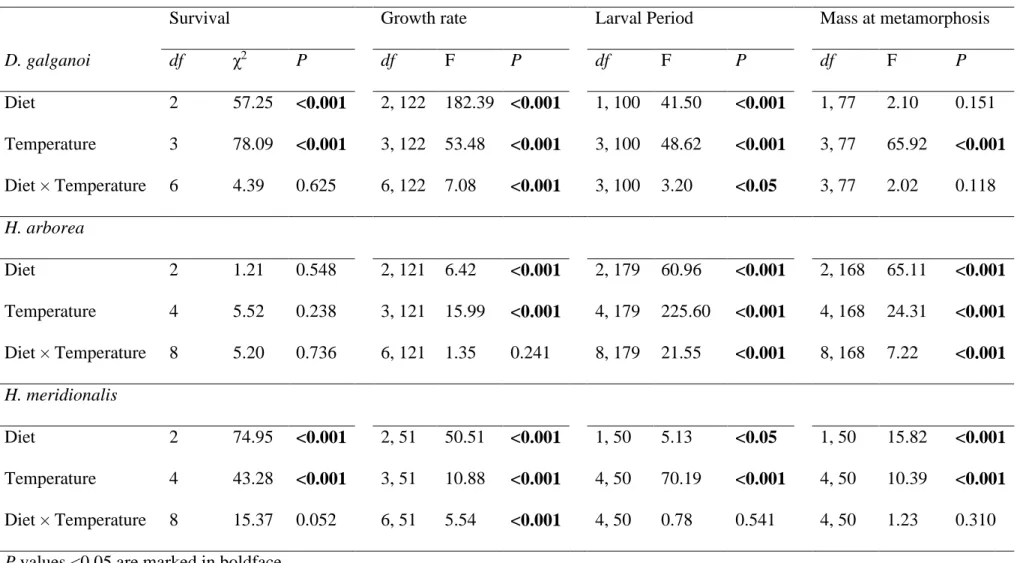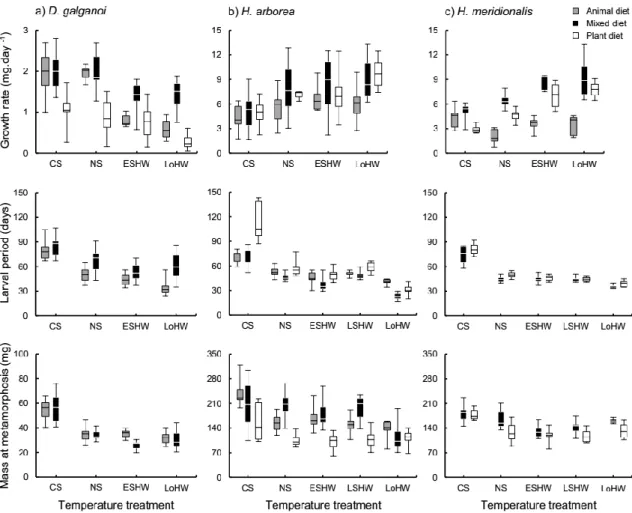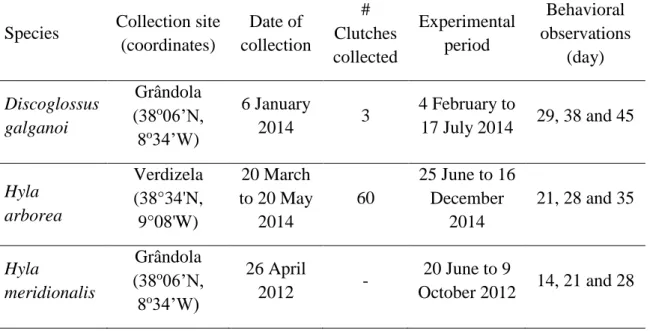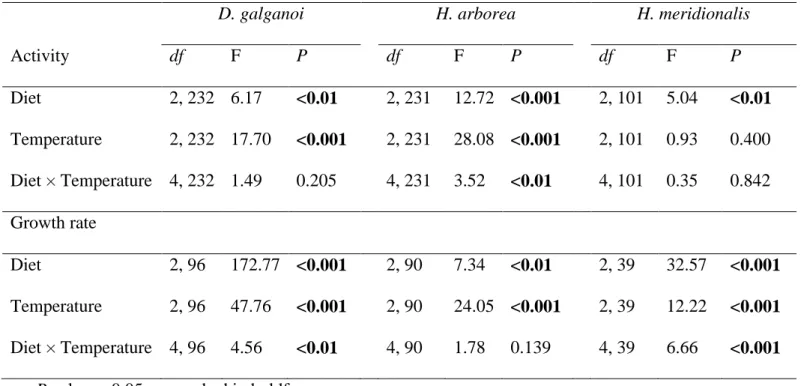UNIVERSIDADE DE LISBOA FACULDADE DE CIÊNCIAS
Warm vegetarians? Heat wave effects on aquatic omnivorous
ectotherms
Doutoramento em Biologia Especialidade em Ecologia
Bruno Martins Carreira
Tese orientada por:
Professor Doutor Rui Rebelo e Professor Doutor Anssi Laurila
Documento especialmente elaborado para a obtenção do grau de doutor
UNIVERSIDADE DE LISBOA FACULDADE DE CIÊNCIAS
Warm vegetarians? Heat wave effects on aquatic omnivorous
ectotherms
Doutoramento em Biologia Especialidade de Ecologia
Bruno Martins Carreira
Tese orientada por:
Professor Doutor Rui Rebelo e Professor Doutor Anssi Laurila
Júri: Presidente:
● Doutora Maria da Luz da Costa Pereira Mathias Vogais:
● Doutora Maria Del Carmen Díaz Paniagua ● Doutora Verónica Jacinta Lopes Ferreira ● Doutor Paulo Jorge Quintais Cancela da Fonseca ● Doutora Maria Filomena de Magalhães
● Doutor Rui Miguel Borges Sampaio e Rebelo
Documento especialmente elaborado para a obtenção do grau de doutor Fundação para a Ciência e a Tecnologia (FCT) – Bolsa de Doutoramento (SFRH/BD/80341/ 2011)
Fundação para a Ciência e a Tecnologia (FCT) – Projeto Programa Exploratório 2012 (EXPL_BIA-ANM_0932_2012) Fundação para a Ciência e a Tecnologia (FCT) – Financiamento Plurianual a Rui Rebelo
This dissertation should be cited as:
Carreira BM (2016) Warm vegetarians? Heat wave effects on aquatic omnivorous ectotherms. PhD Thesis, Universidade de Lisboa, Portugal
Nota Prévia
A presente tese apresenta resultados de trabalhos já publicados ou em preparação para publicação (capítulos 2 a 5), de acordo com o previsto no nº 2 do artigo 25º do regulamento de Estudos Pós-graduados da Universidade de Lisboa, publicado no Diário de República II série nº 57 de 23 de Março de 2015. Tendo os trabalhos sido realizados em colaboração, o candidato esclarece que participou integralmente na conceção dos trabalhos, obtenção dos dados, análise e discussão dos resultados, bem como na redação dos manuscritos.
Lisboa, Setembro de 2016 Bruno Martins Carreira
To the pirates of the past, present and future
i
ACKNOWLEDGMENTS
The people I must thank for the most are my supervisors, Rui Rebelo and Anssi Laurila. I am most thankful for all that I learned from and with you, for the opportunities you gave me, for all your support and hard work and most of all for your endless patience. You did way more than fulfilling your roles as supervisors, I had a really good time around you and I can’t thank you enough for that, it was a pleasure. To Rui for the application for the PhD grant and the project funding, for believing in a crazy idea and enabling it, for always being present, but most importantly for the friendship. To Anssi, for happily embracing yet another loud Portuguese PhD student in his life, for making sure everything worked out in Uppsala, for fighting my gangsta English and for the friendship. I thank Fundação para a Ciência e Tecnologia for my doctoral grant (SFRH/BD/80341/ 2011) and for funding through the Exploratory Program 2012 (EXPL_BIA-ANM_0932_2012). I also thank the British Ecological Society for awarding me with a travel grant in 2015 to present my work at the European Ecological Federation in Rome. My master students, Nuno Gonçalves and Vanessa Pinto, for embracing this project, for their dedication and hard work in running the experiments, and for their high spirits that created the most pleasant working environment.
Vânia Baptista for her exceptional work as lab assistant, for sharing with me the burden of the preparation of the samples for stable isotope analysis and for soloing the crayfish lipid profiles, forever in your debt. Anxo for his dedication in the experimental facilities. Germán Orizaola for his ever readiness to collaborate, but most importantly for showing me what a good power point presentation looks like. Pedro Segurado for his good spirited and always so preoccupied collaboration. David Outomuro for his countless statistical advisement. Eryn McFarlane for revising my English and finding my hypothesis’ testes. Francisco Moreira for helping out with last minute figures and formatting.
To those helping me in the field and in the lab: Nicolas, R. Rodrigues, R. Cunha, Fernando, Daniel, D. Simões, G. Martins, A. Santos and Katrin; and Ana Sampaio.
To my office mates and friends in Sweden: Yvonne, David and Magnus for putting up with an angry Skyper and for all the help they gave me in settling in. To my office mates and friends in Portugal: Marta, Inês, Ana Leal, Ana Raínho and Nuno for enduring my craziness and providing me with inspiring material.
To Maria, Javi, Eryn, Ivain, Josefine, Pavitra, Emilien, Will, Rado, Frank, Jacob and Katja for keeping fika interesting and relaxed.
To the friends that in Portugal and in Sweden accompanied me in this journey through the warm light and the cold darkness that made for the chaos of these last five years, in which so little was constant. Thank you for sticking around.
Aos meus pais e irmãos por todo o apoio, por se preocuparem e por sempre acreditarem em mim.
iii TABLE OF CONTENTS ACKNOWLEDGMENTS i RESUMO v ABSTRACT xi CHAPTER 1 1 General Introduction Metabolic ecology 3
Food web implications 5
Freshwater communities 6
Climate change 7
Invasive alien species 10
Stable isotopes 12
Goals 14
Papers presented 16
References 19
CHAPTER 2 29
Warm vegetarians? Heat waves and diet shifts in tadpoles
Abstract 31
Introduction 32
Material and Methods 35
Results 44
Discussion 52
Acknowledgments 57
References 58
CHAPTER 3 63
Disentangling stress: complex response of tadpole activity level to diet and temperature
Abstract 65
Introduction 66
Material and Methods 67
Results 72
Discussion 77
Acknowledgments 81
iv
CHAPTER 4 85
Heat waves in a temperate climate: diet shifts and increased performance of a subtropical invasive crayfish?
Abstract 87
Introduction 88
Material and Methods 90
Results 95
Discussion 101
Acknowledgments 105
References 106
CHAPTER 5 111
Heat waves increase herbivory in a freshwater snail
Abstract 113
Introduction 114
Material and Methods 116
Results 118 Discussion 119 Acknowledgments 121 References 121 CHAPTER 6 125 General Discussion
Performance on animal diets 127
Performance on plant diets 128
Changes in the food quality 129
Assimilation shifts 130
Adaptive value 131
Altered feeding preferences 132
Thermal background and feeding preferences 134
Heat waves: present and future 136
Implications for freshwater food webs 137
Final considerations 138
v
Resumo
Algumas questões ecológicas clássicas voltaram a ganhar relevância devido às projecções futuras das alterações climáticas em curso e à perda de biodiversidade sem precedentes a que se assiste mundialmente. Entre estas questões destaca-se a influência da temperatura na aquisição de nutrientes em animais ectotérmicos, recentemente identificada como fundamental para a compreensão dos impactos das alterações globais e para uma previsão realista das alterações nos ecossistemas.
Os resultados de estudos experimentais recentes mostraram que a temperatura tem efeitos diferentes nas componentes anabólica e catabólica do metabolismo, que podem favorecer a assimilação de dietas vegetais (ricas em hidratos de carbono) a temperaturas mais elevadas. O efeito da temperatura nos processos catabólicos é mais forte do que nos processos anabólicos e, consequentemente, o maior aumento da respiração do que do crescimento à medida que a temperatura aumenta dá origem a uma maior necessidade de carbono do que de azoto. Além disso, visto que um aumento da temperatura promove um maior aumento da taxa de consumo do que da taxa de assimilação na parede do intestino, as temperaturas mais elevadas podem dificultar a assimilação de nutrientes de digestão lenta. Sendo, assim, favorecida a assimilação de nutrientes de menores dimensões e estruturalmente menos complexos, como os hidratos de carbono. Outros estudos sugerem ainda que, dado o maior teor em hidratos de carbono das dietas vegetais, o aumento do seu consumo pode ajudar os animais ectotérmicos a satisfazer as maiores necessidades energéticas impostas pelas temperaturas mais elevadas, porque os hidratos de carbono constituem fontes de energia de disponibilização rápida. E, de facto, alguns estudos recentes demonstraram um aumento da preferência por fontes de hidratos de carbono por ectotérmicos sujeitos a temperaturas elevadas.
vi
As comunidades dulçaquícolas são particularmente vulneráveis às alterações climáticas, uma vez que são compostas maioritariamente por espécies ectotérmicas, cujo metabolismo é fortemente influenciado pela temperatura. Esta relação é particularmente preocupante, visto que as projecções climáticas indicam, para além do aquecimento global, um aumento da frequência e intensidade de eventos climáticos extremos, como por exemplo inundações, secas e ondas de calor. Embora negligenciados até recentemente, estes eventos climáticos discretos podem representar uma forte ameaça, uma vez que os organismos podem ser incapazes de responder de forma eficaz e imediata. Os modelos climáticos de circulação geral indicam um aumento da intensidade, frequência e duração das ondas de calor, especialmente nas áreas actualmente mais afectadas por estas anomalias climáticas, como é o caso da bacia do Mediterrâneo. Na Península Ibérica, o aumento da severidade das ondas de calor decorrerá sobretudo no mês de Junho, coincidindo com o período de seca dos charcos temporários mediterrânicos.
O objetivo principal desta tese foi investigar os efeitos da temperatura na aquisição de nutrientes em omnívoros ectotérmicos pertencentes a três Filos diferentes. Mais especificamente, procurou-se determinar: 1) se o desempenho com dietas animais diminuiu a temperaturas mais elevadas; 2) se o desempenho com dietas vegetais aumentou a temperaturas mais elevadas; 3) se a assimilação dos dois tipos de dieta variou com a temperatura; 4) se as alterações na assimilação melhoraram o desempenho dos indivíduos; e 5) se as alterações na assimilação foram devidas a mudanças nas preferências alimentares. Como modelos de estudo foram utilizadas cinco espécies dulçaquícolas, facilmente encontradas em charcos temporários mediterrânicos: larvas de três anuros que se reproduzem ao longo de um gradiente climático sazonal (Discoglossus
vii
decápode invasor (Procambarus clarkii). Os indivíduos destas espécies foram alimentados à base de dietas animais, vegetais ou mistas, e expostos a regimes térmicos semelhantes aos impostos pelas ondas de calor de curta duração que ocorrem actualmente no sudoeste de Portugal, ou a ondas de calor prolongadas, que deverão tornar-se mais frequentes no futuro. As respostas aos tratamentos experimentais foram avaliadas pela medição da sobrevivência dos indivíduos, de alterações nos parâmetros da história de vida e, adicionalmente no caso das larvas de anuro, de alterações comportamentais. Nos indivíduos alimentados com a dieta mista estimaram-se ainda as proporções de material animal e vegetal assimiladas utilizando isótopos estáveis. A quantificação do consumo é uma tarefa difícil em espécies de tamanho reduzido, especialmente quando são aquáticas, e a análise dos rácios de isótopos estáveis (13C/12C, 15N/14N) permitiu a obtenção de estimativas integradas no tempo da dieta destas espécies.
A tese está organizada em 6 capítulos, correspondendo os capítulos 1 e 6, respectivamente, a uma introdução geral e a uma discussão onde é feita uma integração dos principais resultados. Os capítulos 2 a 5 correspondem a trabalhos já publicados ou submetidos para publicação em revistas com circulação internacional e sujeitas a revisão por pares.
No Capítulo 2 são apresentados os resultados das experiências realizadas com vertebrados (três espécies de anuros). Foi demonstrada a ocorrência de um gradiente na especialização das preferências alimentares das larvas das três espécies, que é concordante com o gradiente de temperatura mínima a que estas larvas estão naturalmente sujeitas – de uma maior carnivoria na espécie que se reproduz em águas mais frias a uma maior herbivoria na espécie que se reproduz nas mais quentes. Observou-se também uma alteração da qualidade das dietas com a temperatura, caracterizada por uma diminuição do desempenho com dietas animais e por um aumento do desempenho com dietas
viii
vegetais a temperaturas mais elevadas. Foram ainda detectadas alterações na assimilação de matéria vegetal em resposta às ondas de calor que, apesar de não terem sido uniformes em todas as espécies, foram sempre no sentido de uma maior assimilação da dieta vegetal. Embora adaptativa numa espécie e potencialmente adaptativa noutra, esta resposta revelou-se mal-adaptativa na espécie mais carnívora.
No Capítulo 3 são apresentadas as alterações comportamentais sofridas pelos girinos no decurso da experiência referente ao capítulo 2. Demonstrou-se que a alteração da qualidade das dietas experimentais induzida pela temperatura foi acompanhada por mudanças na actividade dos girinos de todas as espécies. Usando a redução no crescimento como uma indicação de stress, verificou-se que a variação nos níveis de actividade dos girinos em função do nível de stress a que estiveram sujeitos se adequou a uma típica curva de desempenho. Neste caso, a baixa actividade nos dois extremos da curva é explicada por ausência de stress (cauda à esquerda) e stress intenso (cauda à direita), enquanto que a actividade elevada no centro da distribuição é explicada por uma resposta a níveis moderados de stress, cuja eficácia depende da sua intensidade. Verificou-se que os girinos regularam a sua actividade de acordo com os níveis de stress a que foram sujeitos nas diferentes combinações de dieta e temperatura.
No Capítulo 4 foram estudadas as respostas de uma espécie invasora de decápode – o lagostim-vermelho-americano. O aumento da assimilação de material vegetal nas ondas de calor foi visível essencialmente nos indivíduos juvenis, permitindo-lhes a manutenção de uma taxa elevada de crescimento na onda de calor longa, o que é uma indicação que esta alteração na assimilação da dieta vegetal foi adaptativa. Surpreendentemente, embora esta espécie seja nativa de regiões com climas mais quentes do que o da Península Ibérica, os indivíduos de P. clarkii, juvenis e adultos, foram afectados negativamente pelas ondas de calor. No entanto, a assimilação diferencial da
ix
dieta vegetal pelos juvenis demonstrou a existência de um potencial para o aumento do impacto desta espécie por herbivoria com o aumento da temperatura, potencialmente agravando os seus impactos económicos nas plantações de arroz.
No Capítulo 5, onde são apresentados os resultados da experiência realizada com um gastrópode, verificou-se um aumento da assimilação da dieta vegetal em ambas as ondas de calor, o que na onda de calor de longa permitiu aos caracóis alimentados com a dieta mista alcançar uma taxa de crescimento superior, sem custos evidentes no número de ovos produzidos. Além disso, o aumento desproporcional na assimilação de material vegetal pelos caracóis na onda de calor curta, indicou que para além de um efeito da temperatura na assimilação desta dieta, pode ainda ter havido alteração das preferências alimentares e aumento da herbivoria.
De um modo geral, as respostas em termos de sobrevivência e da alteração dos parâmetros da história de vida suportam que a qualidade das dietas variou com a temperatura, e que o desempenho com dietas animais diminuiu a temperaturas mais elevadas, contrariamente ao desempenho com dietas vegetais, que aumentou. Embora o tipo de onda de calor responsável pelo aumento na assimilação da dieta vegetal tenha variado e as espécies tenham respondido com intensidades diferentes, em geral as ondas de calor aumentaram a assimilação de material vegetal, o que foi adaptativo em quase todas as espécies. Apesar de não terem sido medidos consumos reais (mas sim a proporção de material assimilado com diferentes origens), os resultados sugeriram ainda que, em alguns casos, a maior assimilação da dieta vegetal a temperaturas mais elevadas pode ter sido causada por um aumento da herbivoria, ou seja, alteração nas preferências alimentares e não apenas alterações nas taxas de assimilação de alimentos já ingeridos.
Em conclusão, a repetibilidade dos resultados em espécies de três Filos diferentes sugere fortemente que a temperatura tem um papel importante na modulação da aquisição
x
de nutrientes – um efeito latente e generalizado em organismos ectotérmicos que era desconhecido até muito recentemente. A maior assimilação de material vegetal, ou mesmo da herbivoria, pode ajudar os ectotérmicos omnívoros a suportar o stress imposto por temperaturas mais altas. Contudo, uma redução generalizada do nível trófico destes organismos pode desencadear alterações no funcionamento e estrutura das comunidades de água doce e das suas teias alimentares. Ainda que os padrões aqui descritos revelem apenas uma vertente da influência da temperatura na aquisição de nutrientes, a consciência da existência deste efeito irá contribuir para uma melhor compreensão e reavaliação dos efeitos ecológicos das alterações climáticas em curso.
xi
Abstract
Freshwater communities are particularly vulnerable to climate change, as they are mainly composed of ectotherm species, whose metabolism is strongly influenced by temperature. This relationship is particularly relevant, as projections show both a global warming and an increase in the frequency, intensity and duration of extreme climatic events such as heat waves. Measurements of imbalanced temperature effects on various metabolic aspects of ectotherms lead to the suggestion that these organisms may optimize energetic intake at higher temperatures by increasing herbivory and avoiding protein-rich animal diets.
In this thesis, I tested the effects of different types of heat waves on diet assimilation (and indirectly on diet choice) of five species of freshwater omnivorous ectotherms, belonging to three different phyla. As study models, I used species commonly found in Mediterranean temporary ponds: the tadpoles of three anuran species breeding along a seasonal climatic gradient (Discoglossus galganoi, Hyla arborea and Hyla
meridionalis), the gastropod Radix balthica and the invasive crayfish Procambarus clarkii. Individuals were fed animal, plant or mixed diets and exposed to temperature
treatments simulating the current short heat waves, as well as long heat waves expected to become more frequent in the future. Treatment responses were recorded in terms of survival and life history traits. In the individuals feeding on the mixed diet, the proportion of animal and plant material assimilated was estimated with stable isotopes.
Overall, I found evidence that performance at higher temperatures decreased on animal diets and increased on plant diets, suggesting that diet quality changed with temperature. Although the type of heat wave inducing assimilation shifts varied and the species responded to different extents, heat waves generally increased the assimilation of plant material, and this was adaptive in almost all species. Furthermore, the seasonal
xii
climatic gradient in the three anuran species was found to match a gradient in their feeding preferences, the degree of herbivory increasing with minimum temperature experienced in nature. Surprisingly, albeit native to climates warmer than the Iberian Peninsula, the invasive crayfish P. clarkii was negatively affected by the heat waves. However, the results of nutrient assimilation showed that warmer temperatures may increase this species’ impact in freshwater communities through increased herbivory.
In conclusion, my results suggest that temperature plays an important role in modulating nutrient acquisition in omnivorous ectotherms. A greater assimilation of plant material or increased herbivory may help ectotherms to cope with the challenges imposed by higher temperatures. However, a reduction in the trophic positions of the omnivores may trigger changes in the functioning and structure of freshwater communities and food webs.
1
CHAPTER 1
3
CHAPTER 1
General Introduction
Metabolic ecology
Climate change unfolded many ecological questions that have gained particular relevance under the projections for future climates and the current unprecedented biodiversity loss. Among these topics, the influence of temperature on nutrient acquisition by organisms is now attracting a great deal of interest and recently became the focus of several studies. Indeed, better understanding of temperature and nutrient interactions across ecological organization levels was recently identified as critical for realistic predictions of ecological responses to global change drivers (Cross et al. 2015).
Several large-scale studies on marine and freshwater fish communities have found an association between latitude and the prevalence of herbivory, with higher relative abundance and richness of herbivorous species at lower latitudes (Floeter et al. 2005, Behrens & Lafferty 2007, Jeppesen et al. 2010). Furthermore, the extent of herbivory in omnivorous invertebrates was found to increase at lower latitudes (Pennings et al. 2009, Schemske et al. 2009, Gonzalez-Bergonzoni et al. 2012). Several factors could be driving these patterns (Floeter et al. 2005): (1) insufficient time for the evolution of herbivory or for the expansion of herbivorous species into temperate and cold waters; (2) a selection pressure against herbivory caused by the seasonal and prolonged shortage of algae in temperate habitats; (3) lower palatability of algae at higher latitudes; (4) an earlier evolution of herbivory among tropical fish communities and, consequently, a more efficient use of low energy food resources such as algae and sponges. However, discarding the previous hypotheses, the authors suggest (5) temperature-related physiological constraints to herbivory at higher latitudes, implying that some herbivorous
4
fishes may be unable to meet their energetic demands in colder temperatures due to a thermal constraint on the digestion of algae. This may be only a partial explanation, as it is also possible that some carnivorous ectotherms are unable to meet their nutritional demands at higher temperatures.
Experimental evidence suggests that various components of metabolism of ectotherms may scale differently with temperature and that these imbalanced effects may favour herbivory at higher temperatures. Some studies show that metabolic processes may positively discriminate plant diets (carbohydrate-rich) at higher temperatures. By promoting a greater increase in feeding and gut passage rates than in assimilation (Myrick & Cech 2000, Seifert et al. 2014), higher temperatures passively favor the assimilation of smaller and structurally less complex nutrients, increasing the assimilation efficiency of carbohydrates. Likely linked to this, the protein to carbohydrate assimilation ratio of
Procambarus zonangulus and Procambarus clarkii, two freshwater crayfishes, was found
to shift to a greater assimilation of carbohydrates as temperature increases (Croll & Watts 2004). Another aspect in favor of greater herbivory at higher temperatures is the enhanced digestion of plant material aided by the more abundant and diverse gut microflora (Clements et al. 2009).
Alternatively, other studies highlight that increasing the consumption of plant diets (carbohydrate-rich) would help ectotherms to better cope with the greater energetic demands at higher temperatures. The temperature effect on catabolic processes, which takes place in all of the organism’s cells and are proportional to tissue volume, is stronger than on anabolic processes, which are limited by the passage of molecules trough bidimensional structures like the gut or cell walls. Consequently, as temperature rises it promotes a greater increase in respiration than in growth and increases demand for carbon over nitrogen (Karl & Fischer 2008, Forster et al. 2011). Furthermore, because
5
temperature promotes a greater increase in metabolic than in feeding rates (Kingsolver & Woods 1997, Lemoine & Burkepile 2012), higher temperatures decrease digestion efficiency and the consumption of fast energy sources could compensate for this. Indeed, recent studies showed not only that higher temperatures increased caterpillar preference for carbohydrates (Lee et al. 2015), but also that locusts preferred higher temperatures when fed on carbohydrate-rich diets (Clissold et al. 2013). More recent studies showed a seasonal variation in the trophic level of marine copepods, lower in the summer, and an avoidance of animal diets (protein-rich) at higher temperatures (Boersma et al. 2016, Malzahn et al. 2016). The same studies also showed an increased performance on plant diets at higher temperatures, in opposition to a decreased performance on animal diets, leading the authors to suggest that increasing the assimilation of plant material at higher temperatures is an adaptive response.
The large-scale patterns in the abundance and relative richness of herbivorous and omnivorous fishes, as well as the imbalanced temperature effects on various metabolic aspects suggest that ectotherms may optimize energetic intake at higher temperatures by increasing herbivory and avoiding protein-rich diets. However, some studies found no evidence for temperature-induced changes in the feeding preferences of locusts (Miller et al. 2009) and freshwater snails (Zhang et al. 2016), but only increased consumption ratios driven by the accelerated metabolism at higher temperatures (Gillooly et al. 2001).
Food web implications
Temperature-induced changes in the feeding preferences that compensate for the changes in the relative quality of animal and plants diets are unlikely to affect all ectotherms equally. Over short time scales this response should be adopted by omnivorous species, which – given their necessarily higher trophic plasticity – should
6
more easily shift their trophic preferences. The potential unidirectional shift toward greater herbivory induced in omnivorous ectotherms by the increasing temperatures may have a strong impact on freshwater food webs (Estes et al. 2011), since feeding behavior is particularly important in shaping their structure (Kortsch et al. 2015).
The trophic downgrading that results from temperature-induced increased herbivory in omnivores may affect food webs in two distinct ways. Firstly, omnivory buffers the effects of perturbations by promoting stable equilibria and reducing the probability of extinctions (Vandermeer 2006, Ingram et al. 2009). The greater array of omnivore trophic interactions increases food web resilience (Stouffer & Bascompte 2011), as perturbations are retained and diffused through the many trophic links, delaying or stopping propagation to other trophic levels (Krause et al. 2003, Bascompte et al. 2005, Stouffer & Bascompte 2011). Ultimately, omnivory reduces the likelihood of trophic cascades or strong population cycles (Thompson et al. 2007). Secondly, macrophytes are important to the maintenance of the “clear water state” in freshwaters and the greater herbivory associated with trophic downgrading may induce a switch from a clear to a turbid state, as phytoplankton replaces the macrophyte community (Rodríguez et al. 2003). This shift is usually accompanied by deep changes in food web structure, through cascading effects, driven by the loss of biodiversity during the transition from clear to turbid state (Rodríguez et al. 2003).
Freshwater communities
Freshwater habitats cover 0.8% of the Earth’s surface and contain only 0.01% of the world’s water, yet they are home to a high number of animal and plant species, with unique adaptations. Recent estimates indicate that freshwater habitats may harbor as much as 6% of the global biodiversity and one third of all vertebrate species (Dudgeon et
7
al. 2006). This places freshwater biodiversity disproportionally at risk (Parmesan 2006, Perkins et al. 2010, Woodward et al. 2010), and raises great concern as biodiversity loss in freshwater habitats is far more pronounced than in the most endangered terrestrial ecosystems (Ricciardi & Rasmussen 1999). Often occurring isolated and fragmented within the terrestrial landscape (Perkins et al. 2010), freshwater habitats are particularly vulnerable to climate change (Hobday & Lough 2011). Furthermore, the effects of temperature change are expected to be particularly pervasive, as freshwaters are dominated by ectotherms, which compose approximately 99% of their communities (Parmesan & Yohe 2003, Woodward et al. 2010). Consequently, global warming is expected to have a strong impact on individual metabolism and by extension on the physiology, bioenergetics, behavior, abundance and distribution of ectotherms, which will affect all organizational levels of freshwater ecosystems (Ings et al. 2009).
Climate change
Over the last decades an increasing number of studies showed broad effects of climate change on natural systems (Chapman et al. 2014). Climate change effects at the species level has been reported in morphology (Sheridan & Bickford 2011, Goodman et al. 2012), abundance and distribution (Barry et al. 1995, Parmesan & Yohe 2003, Perry et al. 2005, Thomas 2010, Dietl & Flessa 2011), and phenology (Parmesan & Yohe 2003, Walther 2004, Parmesan 2006, Burgmer et al. 2007, Pau et al. 2011). At the community level, changes have been reported in species interactions (Voigt et al. 2003, Van der Putten et al. 2004, Schweiger et al. 2008, Tylianakis et al. 2008, Van der Putten et al. 2010) and community diversity (McKee et al. 2002, Daufresne et al. 2009); and at ecosystem level altered function and service provisioning (Traill et al. 2010, Lavergne et al. 2010).
8
Most of this research addressed changes in the mean climatic conditions. However, changes in mean values are long-term trend effects and organisms may acclimate through phenotypic plasticity, evolve genetic adaptations or migrate and follow the displacement of suitable habitats (Gunderson et al. 2010, Hoffmann & Sgrò 2011). By contrast, discrete weather events may pose a greater challenge, because organisms may be unable to display an immediate and effective response, even if they have the potential to evolve genetic adaptations (Reusch et al. 2005). Neglected until recently, short-term stress resulting from increased climatic variability and extreme climatic events is now recognized as an important component of climate change (Chapman et al. 2014, Vasseur et al. 2014). These events constitute large, infrequent, stochastic perturbations (e. g. floods, droughts, heat waves) that can severely affect species’ fitness and life-history traits, and change ecological processes (Thibault & Brown 2008, Clusella-Trullas et al. 2011, Paaijmans et al. 2013, Kingsolver et al. 2013).
Varying in duration and intensity, heat waves are considered to occur when the daily maximum temperature exceeds the average maximum temperature by 5oC for more than five consecutive days, the reference period being 1961–1990 (Frich et al. 2002). Recent studies showed that heat waves were responsible for episodes of mass mortality (Garrabou et al. 2009); decreased condition, immune function and storage reserves (Fischer et al. 2014); range shifts and loss of genetic diversity (Reusch et al. 2005); and changes in species interactions (Eggers et al. 2012), community structure (Ma et al. 2015) and ecosystem function (Wernberg et al. 2012).
Global climatic models project more intense heat waves, with positive anomalies greater than 3°C; more frequent heat waves, with up to a 31% increase in the frequency of occurrence; and longer lasting heat waves, with the average duration expected to increase up to 35% (Meehl & Tebaldi 2004). A severity increase expected to be more marked in
9
the areas currently most susceptible to heat waves, such as the Mediterranean basin, one of the world’s two most prominent climate change “hot-spots” (Meehl & Tebaldi 2004, Giorgi 2006). In the Iberian Peninsula, greater severity of heat waves should be concentrated in the month of June (Dasari et al. 2014). Including increased temperature variability, current climatic models explain the occurrence of events statistically extremely unlikely such as the summer of 2003, for which heat wave conditions persisted over nearly 50 days (Schär et al. 2004, Dasari et al. 2014).
In the southwest of Portugal, heat waves occur frequently during spring, when important freshwater ecosystems such as Mediterranean temporary ponds are home to larvae and adults of many ectotherm species. Typically, this region is afflicted by a heat wave in the end of April that lasts on average 7.8 ± 1.3 days, which in some years is followed by a second heat wave in mid-May that lasts on average 7.5 ± 1.3 days (B. M. Carreira, unpubl. data 2002-2012; Fig. 1A). A five-year survey (2010-2014) carried out in 42 temporary ponds of Southwest Portugal (Fig. 1B) showed that during April and May the water temperature ranged from 17 to 25oC, with an average temperature of 20oC (R. Rebelo, unpubl. data).
10
Invasive alien species
Besides climate change, freshwater ecosystems suffer from the effects of other global change drivers that may interact with each other, further increasing damages to their communities (Vitousek et al. 1997, Pereira et al. 2010). For instance, freshwaters are also expected to be strongly afflicted by invasive alien species (IAS), especially in the Mediterranean (Sala et al. 2000, Theoharides & Dukes 2007). The high connectivity of freshwater environments facilitates spreading of IAS and the weakening or removal of geographic barriers by climate change may provide new suitable habitats, opening a window for the expansion of IAS (Dukes & Mooney 1999, Pyšek & Richardson 2010, Leishman & Gallagher 2015). In turn, the impacts of IAS at the invaded areas may
Figure 1. A) Average
daily air temperatures at the field station in Grândola for the period of 2002-2012; minimum temperature in blue, average temperature in green and maximum temperature in orange. B) Spatial distribution of the 42 temporary ponds in the Southwest Portugal for which temperatures were surveyed for the period of 2010-2014; the dots mark temporary ponds and star marks the field station in Grândola (Fig. 1B).
11
increase ecological susceptibility to climate change and impose additional biotic stress upon freshwater food webs (Perkins et al. 2010).
Invasions are more likely to succeed when climatic conditions in the new environments are similar to those in the invasive species native distribution range, but often climatic conditions in the invasive and native ranges differ substantially (Walther et al. 2009, Davidson et al. 2011). For instance, many of the most abundant IAS in Europe are native to tropical and subtropical climates where they experience warmer conditions (Robinet & Roques 2010). Unlike tolerance to the heat, which is largely conserved across species, tolerance to the cold varies among and within species and shapes their global distribution (Araújo et al. 2013). As climate change proceeds, global warming may boost the populations of cold-limited IAS and increase habitat suitability by extending their growing and reproductive seasons, lessening the constraints imposed by cold temperatures (Easterling et al. 1997, Walther et al. 2009, Bradley et al. 2010, Walther et al. 2010). In addition, IAS may also benefit from the changes projected for extreme climatic events, as these strong perturbations often create resource pulses and reduce the communities’ biotic resistance to invaders (Easterling et al. 2000, Parmesan et al. 2000, Chesson et al. 2004, Miriti et al. 2007, Thibault & Brown 2008).
Ranking among Europe’s worst IAS, the red swamp crayfish Procambarus clarkii (Girard, 1852) is native to warm environments in the central south of the USA and the northeast of Mexico, where its optimum growth temperature ranges from 20 to 30ºC (Croll & Watts 2004). This crayfish was first introduced in the Iberian Peninsula in 1973 and rapidly spread through western Europe, being widespread and abundant in the south and sustaining scattered and isolated populations in the north (Chucholl 2011). In Europe, the colder temperatures prompted changes in the life-history of P. clarkii, causing a switch from multivoltine to uni- or bivoltine life cycles and the onset of the breeding
12
period to vary latitudinally according to water temperature (Chucholl 2011; Peruzza et al. 2015). Although well-established in the Iberian Peninsula, the Iberian populations experience average minimum temperatures 2 to 5ºC lower than in the native range, with spring and summer temperatures being 7 to 8ºC lower. However, in this region winter minima are projected to rise 3ºC and heat waves are projected to become longer, more frequent and intense (Jerez et al. 2012, Dasari et al. 2014). These changes could alleviate or temporarily lift the constraints imposed by the cold temperatures and boost P. clarkii populations. Hence, climatic conditions closer to those in the native distribution range may intensify ecological impacts of invasive P. clarkii on biological communities.
Stable isotopes
Studying the diet of animals has always been one of the major challenges in Ecology. Traditional methods such as direct observations and analyses of gut contents or faeces only capture dietary choices over short time windows (Levey & Karasov 1994, Afik & Karasov 1995). Because accounting for the detectability, retention and digestibility of the different prey items and identifying undigested material may be challenging, these inferences are often biased (Kasai et al. 2005). Stable isotopes analysis introduced an expeditious alternative method that provides reliable and time-integrated estimates of the relative importance of the prey items (Szepanski et al. 1999).
Upon nutrient assimilation consumers incorporate the stable isotope ratios of the prey items in their tissues and by comparing the isotopic signatures it is possible to estimate the relative contribution of prey items (sources) and infer diet composition (Inger et al. 2006). Based on Euclidean distances, the earliest stable isotope mixing models allowed only for a restricted number of sources and the output simply reflected the range of possible solutions for the contribution of each prey item (Phillips & Gregg 2001,
13
2003). Nowadays, these models allow for multiple sources and use Bayesian inference to estimate the contribution of the different prey items to the isotopic signature of the consumers by generating potential dietary solutions as true probability distributions (Inger et al. 2010, Parnell 2010, Lemons et al. 2011). Furthermore, these models allow for concentration dependencies of the elements and incorporate uncertainty in the estimation of the isotopic signature of consumers and sources, corrected for each source trophic enrichment factors (TEF), the increase in consumer isotopic ratio compared to its diet (Hopkins & Fergusson 2012, Parnell et al. 2013). In this thesis, the estimation of the study organisms’ feeding preferences was based on stable isotopes signatures. In the stable isotope mixing models the TEF for each of the isotopes, determined using single diet treatments, were specified per species, life stage and sex of the consumers, source (animal and plant diets) and temperature treatment.
Recent Bayesian stable-isotope mixing models are highly sensitive to variation in TEFs and their accurate characterization is of the utmost importance (Bond & Diamond 2011). Although the sources of TEF variation (e.g., taxa, site, tissue) have been reviewed recently by Caut et al. (2009), who developed regression-based methods to estimate TEFs, these estimates should be used only when no data are available. TEFs are calculated when the consumers’ isotopic signature reaches isotopic equilibrium with their sources and stabilizes. However, the rate at which elemental isotopes of the diet are incorporated into consumer tissues, the isotopic turnover, depends on several factors (e. g. body size, growth rate, protein turnover), making it hard to predict the temporal window over which consumer tissues reflect their diet (Martínez del Rio et al. 2009). To relax this assumption, researchers often estimate TEF’s when the half-life of an element in the tissue has been met, since due to the non-linearity of the turnover rate there is no significant change beyond this time point. Half-life values for 13C and 15N turnover rates
14
were determined in non-experimental individuals maintained at 20oC and fed on commercial fish food, and found to be in agreement with values obtained in a recent review (Thomas & Crowther 2015). In all cases experiment duration was set to comfortably exceed the half-life values for 13C and 15N turnover rates.
Goals
In this thesis, I addressed the temperature effects on nutrient acquisition in an array of omnivorous ectotherm species. Experimentally, I attempted to simulate the heat waves currently afflicting Mediterranean temporary ponds in the southwest of Portugal and study its effects on the species survival and life history traits. This allowed for a simplified assessment of the fitness effects of contrasting diets on the performance and activity of the study organisms under current short heat waves, with a parallelism to the potential effects of longer heat waves. Additionally, I assessed the potential for these heat waves to alleviate the constraints imposed by cold and facilitate a subtropical alien invasive species. The use of controlled diets facilitated the assessment of each species’ feeding choices, estimated through the analysis of stable isotope ratios (13C/12C, 15N/14N). By using these methods, I gained an improved insight of temperature effects on nutrient acquisition and obtained time-integrated estimates of the food assimilated by the study organisms, overcoming the obstacle imposed by their small size.
The study species used in this thesis are commonly found in Mediterranean temporary ponds – high-biodiversity freshwater habitats included in the European Union list of priority habitats for conservation, that contain a unique collection of fauna and flora (Oertli et al. 2005). For a wider taxonomic approach, I chose species representative of the most important taxonomic groups of omnivorous ectotherms inhabiting these ponds, both native (anurans and gastropods) or invasive (decapods) (Fig. 2). Although
15
mostly experimental, this approach relied heavily on data collected in field stations in the southwest of Portugal to address realistic temperatures in nature. I opted to use heat waves to study temperature effects on nutrient acquisition by ectotherms because heat waves are common in the study area and, given the ephemeral character of the Mediterranean temporary ponds, the projected changes in their frequency, intensity and duration may have a profound impact in these ecosystems’ communities.
The main goal of this thesis was to study heat waves effects on omnivorous ectotherms from Mediterranean temporary ponds of the southwest of the Iberian Peninsula within the context of metabolic ecology. More specifically the objectives were to determine if:
1. performance on the animal diets decreased at higher temperatures; 2. performance on the plant diets increased at higher temperatures; 3. higher temperatures induced assimilation shifts;
4. assimilation shifts were adaptive;
16
Papers presented
This thesis compiles a series of four papers (one accepted for publication and three manuscripts), each corresponding to a chapter (Chapters 2–5), in which the specific objectives are addressed along with other particularities. These chapters are preceded by a general introduction to the topics focused in the papers (Chapter 1) and followed by a general discussion where the most important findings are integrated and discussed (Chapter 6).
Chapter 2
Carreira BM, Segurado P, Orizaola G, Gonçalves N, Pinto V, Laurila A, Rebelo R
(2016). Warm vegetarians? Heat waves and diet shifts in tadpoles. Ecology 97 (11): 2964–2974.
This chapter addressed all the specific objectives, investigating the role of temperature in determining the feeding preferences of omnivore ectotherms. This was achieved by using tadpoles of three anuran species breeding along a seasonal climatic gradient (Discoglossus galganoi, Hyla arborea, Hyla meridionalis), in which the tadpoles of the earliest species meet lower water temperatures than tadpoles of the later breeding species. Furthermore, this chapter investigated how short heat waves (that these species experience currently) and long heat waves (predicted to increase under climate change) affected tadpole diet assimilation as well as their survival and larval life history.
Chapter 3
Pinto V & Gonçalves N, CarreiraBM, LaurilaA, Rebelo R. Disentangling stress: complex response of tadpole activity level to diet and temperature. Submitted
This chapter addresses the first two specific objectives, investigating how the changes in food quality induced by temperature may affect tadpole foraging and how
17
tadpole activity may follow the general shape of a performance curve in function of stress. This was achieved by assessing the isolated and combined effects of diet and temperature on the activity levels of the tadpoles from the three anuran species investigated in the previous chapter, using growth reduction as an indicator and a measure of stress.
Activity levels are easily measured and often used to assess the effects of multiple stressors in aquatic organisms such as tadpoles. Examples include chemical agents (Bridges 1997, Hatch & Blaustein 2000, Fraker & Smith 2004, Smith & Burgett 2005), predation (Werner & Anholt 1993, Bridges 2002, Davis et al. 2012, Nunes et al. 2013), amount and nutritive quality of food (Werner 1992, Anholt & Werner 1995, Semlitsch et al. 1995, Nicieza & Metcalfe 1997, Laurila et al. 1998, Richardson 2001, Barry 2014), and temperature (Finkler & Claussen 1999, Laurila et al. 2008, Katzenberger et al. 2014). However, there are no studies on the combined effects of diet and temperature on tadpole activity levels and, since food quality changes with temperature, addressing them together may bring new developments in the interpretation of tadpole activity in function of stress.
Chapter 4
Carreira BM, Segurado P, Laurila A, Rebelo R. Heat waves in temperate climate: diet
shifts and increased performance of a subtropical invasive crayfish? Submitted
This chapter addressed all the specific objectives, investigating how current and future heat waves affect a cold-limited invasive species, Procambarus clarkii. As this species undergoes an ontogenetic shift in its feeding preferences from mainly carnivorous juveniles to mainly herbivorous adults, heat wave effects on diet assimilation and the subsequent effects on survival and life history traits were addressed separately for juvenile and adult crayfish. Furthermore, this chapter also addressed the potential for
18
climate change to induce a shift in the trophic niche of this keystone species, potentially aggravating its impacts on aquatic vegetation, as well as its economic damage to crops.
Chapter 5
Carreira BM, Segurado P, Laurila A, Rebelo R. Heatwaves increase herbivory in a
freshwater snail. Submitted
This chapter focused on the three last specific objectives, investigating shifts in the assimilation of the experimental diets induced by short and long heat waves on a freshwater snail, Radix balthica. In addition, this chapter addressed the adaptive value of the shifts by assessing heat wave effects on life history traits. Importantly, however, the main focus of this chapter was to discuss the reason for the greater assimilation of plant material at higher temperatures and bring some clarification into the controversy on the temperature effects on ectotherm feeding preferences. More specifically, it focused on the nature of underlying mechanism responsible for assimilation shifts and whether these reflected altered feeding preferences or resulted from a passive positive discrimination of plant material during assimilation.
19
References
Afik, D., and W. H. Karasov. 1995. The trade-offs between digestion rate and efficiency in warblers and their ecological implications. Ecology 76:2247–2257.
Anholt, B. R., and E. E. Werner. 1995. Interaction between food availability and predation mortality mediated by adaptive behavior. Ecology 76:2230–2234.
Araújo, M. B., F. Ferri-Yáñez, F. Bozinovic, P. A. Marquet, F. Valladares, and S. L. Chown. 2013. Heat freezes niche evolution. Ecology Letters 16:1206–1219.
Barry, J. P., C. H. Baxter, R. D. Sagarin, and S. E. Gilman. 1995. Climate-related, long-term faunal changes in a California rocky intertidal community. Science 267:672– 675.
Barry, M. J. 2014. The energetic cost of foraging explains growth anomalies in tadpoles exposed to predators. Physiological and Biochemical Zoology 87:829–836.
Bascompte, J., C. J. Melián, and E. Sala. 2005. Interaction strength combinations and the overfishing. Proceedings of the National Academy of Sciences of the United States of America 102:5443–5447.
Behrens, M. D., and K. D. Lafferty. 2007. Temperature and diet effects on omnivorous fish performance: implications for the latitudinal diversity gradient in herbivorous fishes. Canadian Journal of Fisheries and Aquatic Sciences 64:867–873.
Boersma, M., K. A. Mathew, B. Niehoff, K. L. Schoo, R. M. Franco Santos, and C. L. Meunier. 2016. Temperature driven changes in the diet preference of omnivorous copepods: no more meat when it’s hot? Ecology Letters 19:45–53.
Bond, A. L., and A. W. Diamond. 2011. Recent Bayesian stable-isotope mixing models are highly sensitive to variation in discrimination factors. Ecological applications : a publication of the Ecological Society of America 21:1017–1023.
Bradley, B. A., D. S. Wilcove, and M. Oppenheimer. 2010. Climate change increases risk of plant invasion in the Eastern United States. Biological Invasions 12:1855–1872. Bridges, C. M. 1997. Tadpole swimming performance and activity affected by acute
exposure to sublethal levels of Carbaryl. Environmental Toxicology and Chemistry 16:1935–1939.
Bridges, C. M. 2002. Tadpoles Balance Foraging and Predator Avoidance: Effects of Predation, Pond Drying, and Hunger. Journal of Herpetology 36:627–634.
Burgmer, T., H. Hillebrand, and M. Pfenninger. 2007. Effects of climate-driven temperature changes on the diversity of freshwater macroinvertebrates. Oecologia 151:93–103.
Caut, S., E. Angulo, and F. Courchamp. 2009. Variation in discrimination factors (Δ 15 N and Δ 13 C): the effect of diet isotopic values and applications for diet reconstruction. Journal of Applied Ecology 46:443–453.
Chapman, S., K. Mustin, A. R. Renwick, D. B. Segan, D. G. Hole, R. G. Pearson, and J. E. M. Watson. 2014. Publishing trends on climate change vulnerability in the conservation literature reveal a predominant focus on direct impacts and long time-scales. Diversity and Distributions 20:1221–1228.
20
Chesson, P., R. L. E. Gebauer, S. Schwinning, N. Huntly, K. Wiegand, M. S. K. Ernest, A. Sher, A. Novoplansky, and J. F. Weltzin. 2004. Resource pulses, species interactions, and diversity maintenance in arid and semi-arid environments. Oecologia 141:236–253.
Chucholl, C. 2011. Population ecology of an alien “warm water” crayfish (Procambarus
clarkii) in a new cold habitat. Knowledge and Management of Aquatic
Ecosystems:29.
Clements, K. D., D. Raubenheimer, and J. H. Choat. 2009. Nutritional ecology of marine herbivorous fishes: ten years on. Functional Ecology 23:79–92.
Clissold, F. J., N. Coggan, and S. J. Simpson. 2013. Insect herbivores can choose microclimates to achieve nutritional homeostasis. The Journal of experimental biology 216:2089–2096.
Clusella-Trullas, S., T. M. Blackburn, and S. L. Chown. 2011. Climatic predictors of temperature performance curve parameters in ectotherms imply complex responses to climate change. The American Naturalist 177:738–751.
Croll, S. L., and S. A. Watts. 2004. The effect of temperature on feed consumption and nutrient absorption in Procambarus clarkii and Procambarus zonangulus. Journal of the World Aquaculture Society 35:478–488.
Cross, W. F., J. M. Hood, J. P. Benstead, A. D. Huryn, and D. Nelson. 2015. Interactions between temperature and nutrients across levels of ecological organization. Global Change Biology 21:1025–1040.
Dasari, H. P., I. Pozo, F. Ferri-yáñez, and M. B. Araújo. 2014. A regional climate study of heat waves over the Iberian Peninsula. Atmospheric and Climate Sciences 4:841– 853
Daufresne, M., K. Lengfellner, and U. Sommer. 2009. Global warming benefits the small in aquatic ecosystems. Proceedings of the National Academy of Sciences of the United States of America 106:12788–12793.
Davidson, A. M., M. Jennions, and A. B. Nicotra. 2011. Do invasive species show higher phenotypic plasticity than native species and, if so, is it adaptive? A meta-analysis. Ecology Letters 14:419–431.
Davis, M. J., J. L. Purrenhage, and M. D. Boone. 2012. Elucidating predator-prey interactions using aquatic microcosms: complex effects of a crayfish predator, vegetation, and atrazine on tadpole survival and behavior. Journal of Herpetology 46:527–534.
Dietl, G. P., and K. W. Flessa. 2011. Conservation paleobiology: putting the dead to work. Trends in Ecology and Evolution 26:30–37.
Dudgeon, D., A. H. Arthington, M. O. Gessner, Z.-I. Kawabata, D. J. Knowler, C. Lévêque, R. J. Naiman, A.-H. Prieur-Richard, D. Soto, M. L. J. Stiassny, and C. a Sullivan. 2006. Freshwater biodiversity: importance, threats, status and conservation challenges. Biological reviews of the Cambridge Philosophical Society 81:163–182. Dukes, J. S., and H. a. Mooney. 1999. Does global change increase the success of
21
Easterling, D. R., B. Horton, P. D. Jones, T. C. Peterson, T. R. Karl, D. E. Parker, M. J. Salinger, V. Razuvayev, N. Plummer, P. Jamason, and C. K. Folland. 1997. Trends for the Globe Emm. Science 277:364–366.
Easterling, D. R., G. A. Meehl, C. Parmesan, S. A. Changnon, T. R. Karl, and L. O. Mearns. 2000. Climate Extremes: observations, modeling, and impacts. Science 289:2068–2074.
Eggers, S. L., B. K. Eriksson, and B. Matthiessen. 2012. A heat wave and dispersal cause dominance shift and decrease biomass in experimental metacommunities. Oikos 121:721–733.
Estes, J. A, J. Terborgh, J. S. Brashares, M. E. Power, J. Berger, W. J. Bond, S. R. Carpenter, T. E. Essington, R. D. Holt, J. B. C. Jackson, R. J. Marquis, L. Oksanen, T. Oksanen, R. T. Paine, E. K. Pikitch, W. J. Ripple, S. a Sandin, M. Scheffer, T. W. Schoener, J. B. Shurin, A. R. E. Sinclair, M. E. Soulé, R. Virtanen, and D. a Wardle. 2011. Trophic downgrading of planet Earth. Science (New York, N.Y.) 333:301– 306.
Finkler, M. S., and D. L. Claussen. 1999. Influence of Temperature, Body Size, and Inter-Individual Variation on Forced and Voluntary Swimming and Crawling Speeds in Nerodia sipedon and Regina septemvittata. Journal of Herpetology 33:62–71.
Fischer, K., M. Klockmann, and E. Reim. 2014. Strong negative effects of simulated heat waves in a tropical butterfly. Journal of Experimental Biology 217:2892–2898. Floeter, S. R., M. D. Behrens, C. E. L. Ferreira, M. J. Paddack, and M. H. Horn. 2005.
Geographical gradients of marine herbivorous fishes: Patterns and processes. Marine Biology 147:1435–1447.
Forster, J., A. G. Hirst, and G. Woodward. 2011. Growth and development rates have different thermal responses. American Naturalist 178:668–678.
Fraker, S. L., and G. R. Smith. 2004. Direct and interactive effects of ecologically relevant concentrations of organic wastewater contaminants on Rana pipiens tadpoles. Environmental Toxicology 19:250–256.
Frich, P., L. V. Alexander, P. Della-Marta, B. Gleason, M. Haylock, a. M. G. Tank Klein, and T. Peterson. 2002. Observed coherent changes in climatic extremes during the second half of the twentieth century. Climate Research 19:193–212. Garrabou, J., R. Coma, N. Bensoussan, M. Bally, P. Chevaldonné, M. Cigliano, D. Diaz,
J. G. Harmelin, M. C. Gambi, D. K. Kersting, J. B. Ledoux, C. Lejeusne, C. Linares, C. Marschal, T. Pérez, M. Ribes, J. C. Romano, E. Serrano, N. Teixido, O. Torrents, M. Zabala, F. Zuberer, and C. Cerrano. 2009. Mass mortality in Northwestern Mediterranean rocky benthic communities: Effects of the 2003 heat wave. Global Change Biology 15:1090–1103.
Gillooly, J. F., J. H. Brown, G. B. West, V. M. Savage, and E. L. Charnov. 2001. Effects of size and temperature on metabolic rate. Science (New York, N.Y.) 293:2248– 2251.
Giorgi, F. 2006. Climate change hot-spots. Geophysical Research Letters 33:1–4.
González-Bergonzoni, I., M. Meerhoff, T. A. Davidson, F. Teixeira-de Mello, A. Baattrup-Pedersen, and E. Jeppesen. 2012. Meta-analysis shows a consistent and
22
strong latitudinal pattern in fish omnivory across ecosystems. Ecosystems 15:492– 503.
Goodman, R. E., G. Lebuhn, N. E. Seavy, T. Gardali, and J. D. Bluso-Demers. 2012. Avian body size changes and climate change: Warming or increasing variability? Global Change Biology 18:63–73.
Gunderson, C. A., K. H. O’hara, C. M. Campion, A. V. Walker, and N. T. Edwards. 2010. Thermal plasticity of photosynthesis: The role of acclimation in forest responses to a warming climate. Global Change Biology 16:2272–2286.
Hatch, A. C., and A. R. Blaustein. 2000. Combined effects of UV-B, nitrate, and low pH reduce the survival and activity level of larval cascades frogs (Rana cascadae). Archives of Environmental Contamination and Toxicology 39:494–499.
Hobday, A. J., and J. M. Lough. 2011. Projected climate change in Australian marine and freshwater environments. Marine and Freshwater Research 62:1000–1014.
Hoffmann, A. A, and C. M. Sgrò. 2011. Climate change and evolutionary adaptation. Nature 470:479–485.
Hopkins III, J. B., and J. M. Ferguson. 2012. Estimating the diets of animals using stable isotopes and a comprehensive Bayesian mixing model. PloS one 7:e28478.
Inger, R., G. D. Ruxton, J. Newton, K. Colhoun, J. A. Robinson, A. L. Jackson, and S. Bearhop. 2006. Temporal and intrapopulation variation in prey choice of wintering geese determined by stable isotope analysis. Journal of Animal Ecology 75:1190– 1200.
Inger, R., R. A. McDonald, D. Rogowski, A. L. Jackson, A. Parnell, J. S. Preston, C. Harrod, C. Goodwin, D. Griffiths, J. T. A. Dick, R. W. Elwood, J. Newton, and S. Bearhop. 2010. Do non-native invasive fish support elevated lamprey populations? Journal of Applied Ecology 47:121–129.
Ingram, T., L. Harmon, and J. Shurin. 2009. Niche evolution, trophic structure, and species turnover in model food webs. The American Naturalist 174:56–67.
Ings, T. C., J. M. Montoya, J. Bascompte, N. Blüthgen, L. Brown, C. F. Dormann, F. Edwards, D. Figueroa, U. Jacob, J. I. Jones, R. B. Lauridsen, M. E. Ledger, H. M. Lewis, J. M. Olesen, F. J. F. Van Veen, P. H. Warren, and G. Woodward. 2009. Ecological networks – beyond food webs. Journal of Animal Ecology 78:253–269. Jeppesen, E., M. Meerhoff, K. Holmgren, I. González-Bergonzoni, F. T. Mello, S. A. J.
Declerck, L. Meester, M. Søndergaard, T. L. Lauridsen, R. Bjerring, J. M. Conde-Porcuna, N. Mazzeo, C. Iglesias, M. Reizenstein, H. J. Malmquist, Z. Liu, D. Balayla, and X. Lazzaro. 2010. Impacts of climate warming on lake fish community structure and potential effects on ecosystem function. Hydrobiologia 646:73–90. Jerez, S., J. P. Montavez, J. J. Goméz-Navarro, P. A. Jimenez, P. Jimenez-Guerrero, R.
Lorente, and J. F. Gonzalez-Rouco. 2012. The role of the land-surface model for climate change projections over the Iberian Peninsula. Journal of Geophysical Research 117:D01109.
Karl, I., and K. Fischer. 2008. Why get big in the cold? Towards a solution to a life-history puzzle. Oecologia 155:215–225.
23
Kasai, A., S. Yano, and A. Takafuji. 2005. Prey-predator mutualism in a tritrophic system on a camphor tree. Ecological Research 20:163–166.
Katzenberger, M., J. Hammond, H. Duarte, M. Tejedo, C. Calabuig, and R. A. Relyea. 2014. Swimming with predators and pesticides: How environmental stressors affect the thermal physiology of tadpoles. PLoS ONE 9:1–11.
Kingsolver, J. G., and H. a Woods. 1997. Thermal sensitivity of growth and feeding in
Manduca sexta caterpillars. Physiological Zoology 70:631–638.
Kingsolver, J. G., S. E. Diamond, and L. B. Buckley. 2013. Heat stress and the fitness consequences of climate change for terrestrial ectotherms. Functional Ecology 27:1415–1423.
Kortsch, S., R. Primicerio, M. Fossheim, A. V. Dolgov, M. Aschan, and S. Kortsch. 2015. Climate change alters the structure of arctic marine food webs due to poleward shifts of boreal generalists. Proceedings of the Royal Society B 282:1–9.
Krause, A. E., K. a Frank, D. M. Mason, R. E. Ulanowicz, and W. W. Taylor. 2003. Compartments revealed in food-web structure. Nature 426:282–285.
Laurila, A., J. Kujasalo, and E. Ranta. 1998. Different antipredator behaviour in two anuran tadpoles: Effects of predator diet. Behavioral Ecology and Sociobiology 83:307–317.
Laurila, A., B. Lindgren, and A. T. Laugen. 2008. Antipredator defenses along a latitudinal gradient in Rana temporaria. Ecology 89:1399–1413.
Lavergne, S., N. Mouquet, W. Thuiller, and O. Ronce. 2010. Biodiversity and climate change: integrating evolutionary and ecological responses of species and communities. Annual Review of Ecology, Evolution, and Systematics, Vol 41 41:321–350.
Lee, K. P., T. Jang, N. Ravzanaadii, and M. S. Rho. 2015. Macronutrient balance modulates the temperature-size rule in an ectotherm. The American Naturalist 186:212–222.
Leishman, M. R., and R. V. Gallagher. 2015. Will there be a shift to alien-dominated vegetation assemblages under climate change? Diversity and Distributions 21:848– 852.
Lemoine, N. P., and D. E. Burkepile. 2012. Temperature-induced mismatches between consumption and metabolism reduce consumer fitness. Ecology 93:2483–2489. Lemons, G., R. Lewison, L. Komoroske, A. Gaos, C.-T. Lai, P. Dutton, T. Eguchi, R.
LeRoux, and J. A. Seminoff. 2011. Trophic ecology of green sea turtles in a highly urbanized bay: insights from stable isotopes and mixing models. Journal of Experimental Marine Biology and Ecology 405:25–32.
Levey, D., and W. Karasov. 2012. Gut passage of insects by European starlings and comparison with other species. American Ornothologists’ Union 111:478–481. Ma, G., V. H. W. Rudolf, and C. Sen Ma. 2015. Extreme temperature events alter
demographic rates, relative fitness, and community structure. Global Change Biology 21:1794–1808.
24
Malzahn, A. M., D. Doerfler, and M. Boersma. 2016. Junk food gets healthier when it’ s warm. Limnology and Oceanography, in press.
Martínez del Rio, C., N. Wolf, S. A. Carleton, and L. Z. Gannes. 2009. Isotopic ecology ten years after a call for more laboratory experiments. Biological Reviews 84:91– 111.
McKee, D., D. Atkinson, S. Collings, J. Eaton, I. Harvey, T. Heyes, K. Hatton, D. Wilson, and B. Moss. 2002. Macro-zooplankter responses to simulated climate warming in experimental freshwater microcosms. Freshwater Biology 47:1557– 1570.
Meehl, G. A, and C. Tebaldi. 2004. More intense, more frequent, and longer lasting heat waves in the 21st century. Science (New York, N.Y.) 305:994–997.
Miller, G. A., F. J. Clissold, D. Mayntz, and S. J. Simpson. 2009. Speed over efficiency: locusts select body temperatures that favour growth rate over efficient nutrient utilization. Proceedings of the Royal Society B: Biological Sciences 276:3581–3589. Miriti, M. N., S. Rodriguez-Buritica, S. J. Wright, H. F. Howe, S. Rodríguez-Buriticá, S. J. Wright, and H. F. Howe. 2007. Episodic death across species of desert shrubs. Ecology 88:32–36.
Myrick, C. A., and J. J. Cech. 2000. Temperature influences on California rainbow trout physiological performance. Fish Physiology and Biochemistry 22:245–254.
Nicieza, A. G., and N. B. Metcalfe. 1997. Growth compensation in juvenile Atlantic salmon: responses to depressed temperature and food availability. Ecology 78:2385– 2400.
Nunes, A. L., A. Richter-Boix, A. Laurila, and R. Rebelo. 2013. Do anuran larvae respond behaviourally to chemical cues from an invasive crayfish predator? A community-wide study. Oecologia 171:115–127.
Oertli, B., J. Biggs, R. Céréghino, P. Grillas, P. Joly, and J.-B. Lachavanne. 2005. Conservation and monitoring of pond biodiversity: introduction. Aquatic Conservation: Marine and Freshwater Ecosystems 15:535–540.
Paaijmans, K. P., R. L. Heinig, R. a. Seliga, J. I. Blanford, S. Blanford, C. C. Murdock, and M. B. Thomas. 2013. Temperature variation makes ectotherms more sensitive to climate change. Global Change Biology 19:2373–2380.
Parmesan, C., T. Root, and M. R. Willig. 2000. Impacts of extreme weather and climate on terrestrial biota. Bulletin of the American Meteorological Society 81:1–10.
Parmesan, C., and G. Yohe. 2003. A globally coherent fingerprint of climate change impacts across natural systems. Nature 421:37–42.
Parmesan, C. 2006. Ecological and evolutionary responses to recent climate change. Annual of Ecology, Evolution and Systematics 37:637–669.
Parnell, A. C., R. Inger, S. Bearhop, and A. L. Jackson. 2010. Source partitioning using stable isotopes: coping with too much variation. PloS one 5:e9672.
Parnell, A. C., D. L. Phillips, S. Bearhop, B. X. Semmens, E. J. Ward, J. W. Moore, A. L. Jackson, J. Grey, D. J. Kelly, and R. Inger. 2013. Bayesian stable isotope mixing
